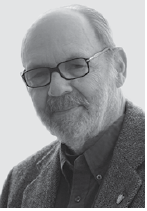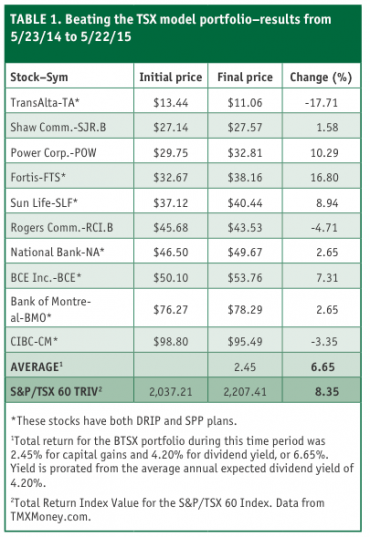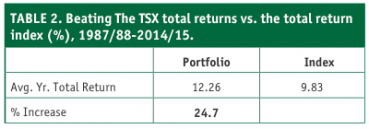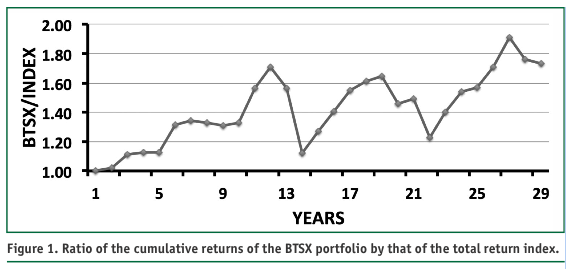BTSX – The Last Hurrah
 Dear friends and readers of Canadian MoneySaver, as I told you a few months ago, I am retiring from my duties with the Beating The TSX column. I wrote my first one in June 1996, so my column has been appearing here for 20 years, and this, the finale, is close to being number 150. I am quite pleased that Ross Grant has taken up the BTSX process and will be carrying on with this work.
Dear friends and readers of Canadian MoneySaver, as I told you a few months ago, I am retiring from my duties with the Beating The TSX column. I wrote my first one in June 1996, so my column has been appearing here for 20 years, and this, the finale, is close to being number 150. I am quite pleased that Ross Grant has taken up the BTSX process and will be carrying on with this work.
It was an acceptable year for our BTSX portfolio, gaining 6.7%, but we were edged by the index during this past turbulent and topsy turvy year when energy stocks lost up to half their value (COS down 51%) and four ‘growth’ stocks that pay either no or miniscule dividends (VRX, BB, CCT, GIB.A) averaged a greater than 65% gain. Still, when you have to give the Canadian government your money for 10 years to get a measly yield of < 2%, our results look pretty good. It is also important to note that four of our 10 stocks increased their yield during the year by an average of
edged by the index during this past turbulent and topsy turvy year when energy stocks lost up to half their value (COS down 51%) and four ‘growth’ stocks that pay either no or miniscule dividends (VRX, BB, CCT, GIB.A) averaged a greater than 65% gain. Still, when you have to give the Canadian government your money for 10 years to get a measly yield of < 2%, our results look pretty good. It is also important to note that four of our 10 stocks increased their yield during the year by an average of  3.2%. As Tom Connolly, a recent and welcome guest at the Guelph ShareClub, has said, “It is virtually certain there will be periods of time when dividend investing will underperform the market.” Table 1 shows what BTSX achieved over the previous year.
3.2%. As Tom Connolly, a recent and welcome guest at the Guelph ShareClub, has said, “It is virtually certain there will be periods of time when dividend investing will underperform the market.” Table 1 shows what BTSX achieved over the previous year.
TransAlta continues to underperform as it has done for several years. They have cut their dividend rather than eliminating it and have also sold some assets. This year to date, the stock has gained 5.1%. Time (and Alberta politics) will tell, but I am still holding on to my shares.
Our performance this year did not have a great deal of influence on our overall returns. Table 2 shows that over our 28-year history we are still doing quite well on an annualized basis, beating the index by about 25%.
These data only reflect the yearly average total return. The strong point of the BTSX system is the influence of compounded reinvested dividends. Those results are much more convincing: $1000 invested in both the BTSX portfolio and the total return index would now be worth $18,056 for our portfolio versus $10,409 for the index. Beating the index by this amount over the number of years most individuals are invested would make a huge difference in their retirement fund.

In 2002, Jack Bogle, the founder and former CEO of the Vanguard Group spoke on the topic ‘The Telltale Chart’ (http://www.vanguard.com/bogle_site/sp20020626.html). He describes how to construct the ‘Telltale Chart’ by simply dividing the cumulative returns of one data series into another, year after year. In the case above, I have divided the cumulative returns of the BTSX portfolio by that of the total return index (Figure 1). Mr. Bogle says that such a graph helps us to determine whether there are real practical differences between the two data sets. Here we are trying to ascertain whether the BTSX approach produces a significant increase in returns. Of course, a simple statistical test like the t-test shows a significant difference (P=0.026, 26df), but is BTSX of sufficient value to put your money into it?
For me, Figure 1 answers that question in the affirmative. The ratio never drops below 1.00 and, although there are some zigs and zags, the overall direction is upward.
I am not going to post a new BTSX portfolio for the coming year. For those of you who have followed this column, you are aware of how it operates, and for those who are new to the process I urge you to contact Ross Grant, whom I am sure will be happy to help you.
And so we come to the end of our 28-year experiment. It has been a great experience for me, and I hope a profitable one for you. My take-home message is that Beating The TSX is a low-cost, passive, emotion-free investment formula that over time and in all market conditions has rewarded individual Canadians with results that significantly exceeded the S&P/TSX60 total return index. The support and appreciation that I have received from Canadian MoneySaver (first from Dale Ennis and recently from Peter Hodson and Lana Sanichar) and from you, the readers, have made my task much easier and I thank you for it. I wish all of you a long and profitable investing career.
As always, I hope this column will generate discussion and I will attempt to answer your questions within the guidelines set by Canadian MoneySaver.
David Stanley, Ph. D., P. O. Box 12, Rockwood, Ontario, N0B 2K0 davids5209@aol.com

